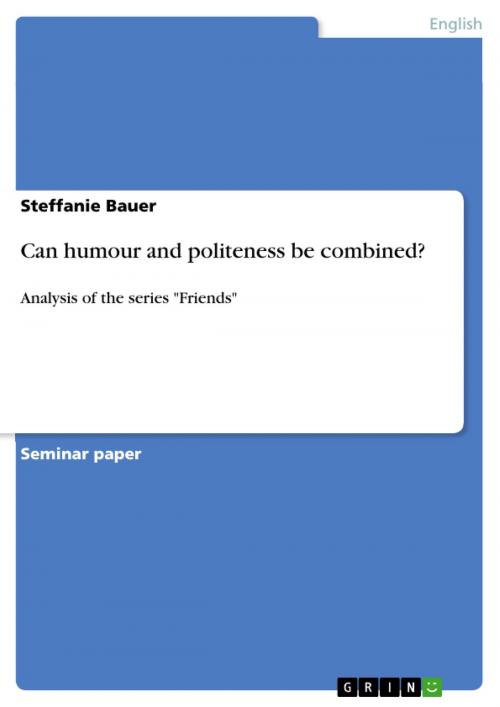Can humour and politeness be combined?
Analysis of the series 'Friends'
Nonfiction, Entertainment, Drama, Anthologies| Author: | Steffanie Bauer | ISBN: | 9783640677122 |
| Publisher: | GRIN Publishing | Publication: | August 6, 2010 |
| Imprint: | GRIN Publishing | Language: | English |
| Author: | Steffanie Bauer |
| ISBN: | 9783640677122 |
| Publisher: | GRIN Publishing |
| Publication: | August 6, 2010 |
| Imprint: | GRIN Publishing |
| Language: | English |
Seminar paper from the year 2007 in the subject English Language and Literature Studies - Linguistics, grade: 2,7, Bielefeld University, language: English, abstract: Introduction This paper deals with an analysis of one episode of the American comedy series Friends and the question whether the constructed conversation used there can be regarded as polite or not. Since this series is very comic, I will look at how politeness and comedy can be combined. Concerning the notion of politeness, I will mainly stick to the theories of Brown and Levinson and Goffman, give brief summaries of their theories and discuss whether the characters in Friends violate the rules mentioned there in order to gain laughter from the audience. I have chosen one single episode and will look deeply at several smaller parts of it in order to answer the question if humour can be used with polite behaviour or if they are not able to coexist. My thesis is that, if you are strict in keeping the rules, is not possible to be polite and funny at the same time because funny utterances can only occur in cases of violation of politeness rules. I will not give a film analysis in this paper. I took the script of this episode and watched it in order to see where laughter is supposed to come, that means to see which phrases are supposed to be funny. These passages are marked in the script (which can be found in the appendix) by an asterisk.
Seminar paper from the year 2007 in the subject English Language and Literature Studies - Linguistics, grade: 2,7, Bielefeld University, language: English, abstract: Introduction This paper deals with an analysis of one episode of the American comedy series Friends and the question whether the constructed conversation used there can be regarded as polite or not. Since this series is very comic, I will look at how politeness and comedy can be combined. Concerning the notion of politeness, I will mainly stick to the theories of Brown and Levinson and Goffman, give brief summaries of their theories and discuss whether the characters in Friends violate the rules mentioned there in order to gain laughter from the audience. I have chosen one single episode and will look deeply at several smaller parts of it in order to answer the question if humour can be used with polite behaviour or if they are not able to coexist. My thesis is that, if you are strict in keeping the rules, is not possible to be polite and funny at the same time because funny utterances can only occur in cases of violation of politeness rules. I will not give a film analysis in this paper. I took the script of this episode and watched it in order to see where laughter is supposed to come, that means to see which phrases are supposed to be funny. These passages are marked in the script (which can be found in the appendix) by an asterisk.















